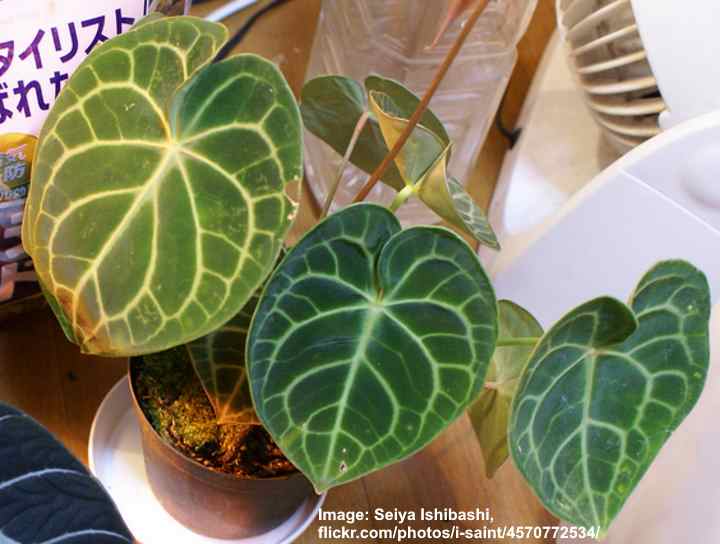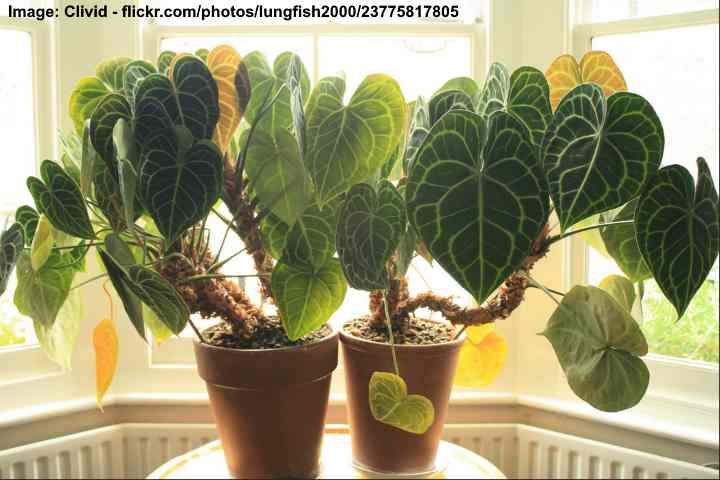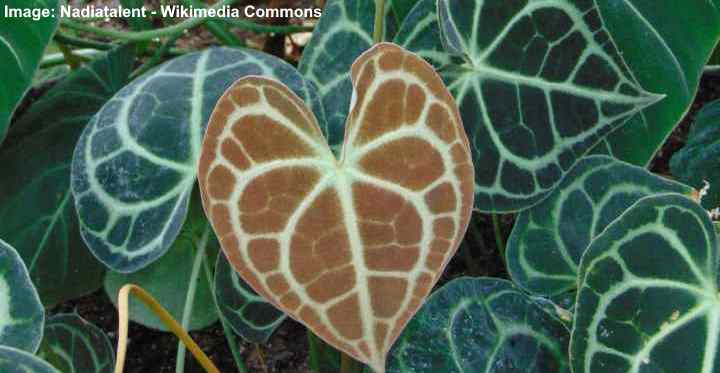The velvet cardboard anthurium, also known as the Anthurium clarinervium, is a gorgeous tropical plant that thrives indoors. The leaves of this anthurium plant are enormous, leathery, and heart-shaped. They have prominent creamy-white veins. The tropical houseplant is also known as the Queen Anthurium and White-Veined Anthurium, among other names. The thick, velvety leaves give the plant its name, Velvet Cardboard Anthurium.
How to care for velvet cardboard anthurium: When it grows in moist soil with excellent drainage, the Anthurium clarinervium thrives in bright, filtered sunlight. During the growing season, water anthuriums fertilize every two months and maintain humidity above 60% when the top 1″ (2.5 cm) of soil is dry.
Between 65°F and 73°F (18°C and 23°C), the perfect temperature is achieved. The anthurium clarinervium plant leaves grow to 8–10 inches (20–25 cm) as an ornamental indoor plant. This plant species grows to about 1 to 2 feet (30 – 60 cm) in height, and most types of anthurium have slow to moderate growth. The anthurium velvet cardboard has a spread of up to 3 feet (90 cm).
Mimicking Anthurium clarinervium’s natural tropical environment in Mexico is crucial. Many growing problems may be avoided by keeping temperatures warm, watering correctly, and maintaining high humidity. Over watering or exposure to direct sunlight, for example, may cause yellowing leaves. The tips of leaves may also turn brown due to a lack of water or direct sunlight.
The Anthurium clarinervium has inconspicuous blooms when it comes to flowering. The crimson waxy blooms of some anthurium houseplants bloom all year long and are highly desired. The flammango lily, Anthurium andreanum, or Anthurium scherzerianum, is one of the most frequent examples with lustrous red spathes and vivid spadices.
Anthurium Clarinervium Care
When it comes to growing indoors in pots, the velvet cardboard anthurium isn’t fussy. To thrive, however, it must be taken care of. The plant will grow for many years and produce beautiful patterned foliage if you meet its requirements. Let’s take a closer look at how to maintain your Anthurium clarinervium plant.
Anthurium Clarinervium Light Requirements

In bright, indirect sunlight, the large attractive leaves of Anthurium Clarinervium get plenty of light. While velvet cardboard anthuriums may survive in low light or direct sunlight, they don’t thrive. The native environment for these species is the rainforest canopy, which is filtered, dappled, or indirect sunlight.
Low to no light does not support Anthurium clarinervium plants. The leaves on your velvet cardboard plant will indicate if it isn’t getting enough light. The vibrancy of the brilliant, creamy-white veins may fade. The plant’s development may also slow down, with leggy stems appearing.
Exposure to direct sunlight for many hours can harm your plant’s development as well. The leaves may become lighter or yellow as a result of direct sunlight. The plant may even start to wilt and be stressed, which you may notice. For healthy growth, place your Anthurium clarinervium on an east-facing windowsill.
Keep the plant a few feet away from the window or have it behind sheer curtains in a south- or west-facing room. Anthuriums prefer bright, well-lit environments. This is an ideal shower plant because of the bright light and humid conditions.
In the summer, you can bring Anthurium clarinervium outside. You should also make sure to put the plant pot in part shade or dappled light. Proper growth outside can be achieved by keeping the anthurium out of the sun’s rays.
Best Soil for Growing Velvet Cardboard Anthurium
Most tropical houseplants, such as Anthurium clarinervium, require well-draining soil to thrive. Just enough moisture should be retained in the potting soil to moisten the roots between watering. It should not be too heavy, however, as it will get soggy and waterlogged.
Root rot, fungal infections, and eventual death of your lovely foliage plant are all caused by an overly moist potting medium. Anthuriums should be grown in a combination of potting soil, peat moss, orchid bark, or perlite to promote expansion. Perlite or orchid bark help aerate the growing medium, while organic matter helps to retain some moisture. Crushed charcoal, mulch, bark chips, and sphagnum moss are other suitable soil drainage additives.
Observing how water flows through and how often you have to water your anthurium is the best way to determine if the potting soil has adequate drainage. Water should begin to flow out of the pot’s drain holes, for example, almost immediately. If you have to water too often or only every so often, you’ll probably need to adjust the potting mix.
How to Water Anthurium Plants

To avoid root rot, make sure not to water your Anthurium clarinervium more than once or twice a week throughout the growing season. Watering less frequently is required in the autumn and winter, perhaps only once a week. Only water the top 1″ to 2″ (2.5 – 5 cm) when it is dry, according to the general rule for watering an anthurium.
Check the soil for dryness before watering a velvet cardboard anthurium. About an inch into the earth, poke your finger. Your plant will need watering if the potting medium is dry. Wait a few days if you notice any moisture before checking again. However, be guided by the soil when watering.
Water your Anthurium clarinervium less often and thoroughly is another top tip for watering it. The roots are adequately hydrated when the soil is thoroughly drenched. Before returning the plant to its bright area, allow all of the excess water to drain away after soaking the soil.
Water your plant only when it is really dry. Since it does not allow the roots to hydrate, this watering method is ineffective for anthuriums. What happens is that you create a moist environment on the surface of the soil. As a result, your plant might exhibit indications of underwatering as well as fungus gnats and white soil mold. The following factors affect the frequency with which you should water your plant:
- Climate—In warm, dry weather, houseplants need watering more often than in chilly weather.
- Season—In the late fall and winter, plants go into a dormant state, requiring less watering..
- Type of pot—Pots made of plastic hold onto moisture better than those made of clay or terracotta. Unglazed clay pots require watering more often than glazed or plastic containers, especially when growing Anthuriums.
Temperature Requirements for Anthurium Clarinervium
Anthurium clarinervium plants thrive in average indoor temperatures, growing indoors. Between 65°F and 73°F (18°C and 23°C) are ideal indoor temperatures. In humidified conditions, up to 86°F (30°C), the velvet cardboard plant can be grown. It does not, however, like being cold. Therefore, make sure it doesn’t get lower than 55°F (13°C). These tropical plants may be grown in your yard if you live in USDA zones 9a to 11. They should be placed in well-drained earth and in a partly shady area.
If summer temperatures are at least 65°F (18°C), you may take your anthurium plants outside. Just place your plant pot in a well-lit area that is protected from direct sun. When nighttime temperatures drop below 60°F (15°C), bring your plant inside.
Anthurium Clarinervium Needs High Humidity

Velvet cardboard anthuriums need to grow in humid conditions, and they prefer warmer temperatures. They are native to tropical rainforests in Mexico and Central and South America. To flourish, anthurium plants require at least 80% humidity. The plant’s lush green leaves and white veins stay vibrant thanks to high humidity, which boosts growth.
It may be difficult to maintain a humid environment at home. As a result, many plant owners keep their Anthurium clarinervium in a bright bathroom. For velvet cardboard anthuriums, there are a few methods to ensure humidity levels are optimal. These are the following:
- Misting—humidity around your plant may be increased by spraying a fine mist of distilled or filtered water. Depending on how dry the air is, do this every day or every other day.
- Use a pebble tray—A humid environment may be created by placing a plant pot on a half-filled tray of stones. The leaves are humidified as the water in the tray evaporates.
- Location—Group houseplants together to raise humidity if your bathroom is too gloomy for growing houseplants.
- Room humidifier—Buying a humidifier can help maintain humidity levels for your tropical indoor plants if you have multiple of them.
How to Fertilize Velvet Cardboard Anthurium for Healthy Growth
During the growing season, Anthurium clarinervium plants don’t need much watering. A normal houseplant fertilizer, diluted to half strength, is advised. From March through September, feed your plant every two months after watering. Don’t fertilize the plant during the autumn and winter. Remember that too much fertilizer, like overwatering, is harmful to your Anthurium clarinervium. Never fertilize or water more than you need to do.
The struggle to avoid mineral salt buildup with indoor tropical plants is becoming increasingly difficult. This is rarely a problem with anthuriums when they’re being grown outdoors. Every three months or so, give your indoor plants a soil flush. Run water through the soil for a few minutes to flush it. This method will aid your plant to grow healthy by rinsing off excess salts from the soil.
Pruning Anthurium Clarinervium

Velvet cardboard anthurium plants may benefit from pruning now and then to encourage growth. Healthy, vigorous growth may be encouraged by snipping off leggy stems or dead foliage. Pruning also improves the plant’s appearance by removing dead, faded, or sick foliage at the same time. You may also propagate Anthurium plants by trimming them.
Pruning your Anthurium clarinervium in the spring, just before the growing season, is the best time. Cut off leggy, straggly branches with sterilized pruning shears or a sharp knife. You can clip off any flower stems that appear because Anthurium clarinervium flowers are not of any aesthetic value. Growth is concentrated in the magnificent foliage with this kind of pruning.
Velvet Cardboard Anthurium Propagation
Root division or stem cuttings are the two best methods to propagate Anthurium clarinervium plants. Remove the plant from its container and carefully separate the roots into two or three pieces before starting new plants from root division. In each pot, fill the sections with the required potting material.
Cut a stem from fresh growth that is about an inch long and propagation by stem cuttings. Allow to grow for a few weeks until 1-inch (2.5-cm) long roots develop in a jar of water. Transfer to a tiny pot with moist potting soil. Place it in a bright location with a plastic bag on top to retain humidity. Until the new plant develops, keep the potting medium moist but not soggy.
Repotting Anthurium Plants

To encourage growth, you might have to repot your Anthurium clarinervium in a bigger pot every two or three years. Anthuriums aren’t root bound quickly because they’re slow to medium growers. To encourage growth, repotting allows you to move the plant to a bigger container. You can also check the roots’ health and potting soil, if necessary.
How to repot an Anthurium clarinervium:
- The plant and root ball should be carefully removed from the pot.
- Untangle the roots and shake off any excess soil if necessary.
- Separate a few portions of the roots, ensuring that each segment has two or three thriving stems, if you are separating the plant.
- Fill a new pot halfway with fresh, sterilized potting soil.
- Fill the remaining space with soil and place the plant in the pot, ensuring that it is growing at the same height as before.
- After the upper section of the ground has dried out, water it thoroughly and begin watering again.
Is Anthurium Clarinervium Toxic?
Yes, humans and animals are poisonous to all sections of velvet cardboard anthuriums. Ingesting insoluble calcium oxalates from the plants may lead to severe stomach irritation. Plant species in the genus Anthurium are poisonous to cats, dogs, and horses, according to the American Society for the Prevention of Cruelty to Animals.
Intestinal discomfort, swelling, and chest discomfort have also been attributed to the consumption of anthurium plants. As a result, pets and children should be kept away from the plants.
Pests and Diseases Affecting Velvet Cardboard Anthurium
Anthurium plants can be infested by houseplant pests such as aphids, spider mites, and mealybugs. Several pests are drawn to the plant because of its need for high humidity. Fungal infections and root rot can both be caused by humid conditions.
One of the main reasons watering only needs to be done on a regular basis is because this. It’s critical to recognize when your houseplants are suffering from insect damage. For more information on how to eliminate plant pests naturally, read this article.
FAQs on Growing Anthurium Clarinervium Plants Indoors
Why isn’t my anthurium clarinervium growing?
Healthy anthurium plants require adequate light and high humidity. Try shifting your big-leafed plant to a location with more light, but no direct sunlight. By spraying your plant twice a day or putting it on a humidifying pebble tray, you may increase humidity if needed.
Why are my velvet cardboard anthurium leaves turning yellow?
Anthurium clarinervium leaves start to turn yellow because they are not receiving enough filtered sunlight. The plant stems may also become droopy and seem to be dead, which is another indication. The yellow leaves on your anthurium plant may be caused by root rot if it is already growing in a bright location. Trim away any diseased, mushy-looking roots and repot your plant in fresh potting soil.
Why do the leaves on my anthurium clarinervium have brown tips?
The tips of velvet cardboard anthurium leaves become brown due to a lack of humidity. Above all, before the next watering, make certain to soak the soil thoroughly and allow it to dry somewhat before you water it again. After that, use a humidifier or mist the air around the anthurium plant on a regular basis.
Do velvet cardboard anthurium plants flower?
Anthurium clarinervium plants bloom, although the blossoms are unusual compared to those commonly available in garden shops. Little, modest blooms characterize velvet cardboard plants. The beautiful heart-shaped leaves with vividly tinted veins of Anthurium clarinervium are cultivated for their beauty.
